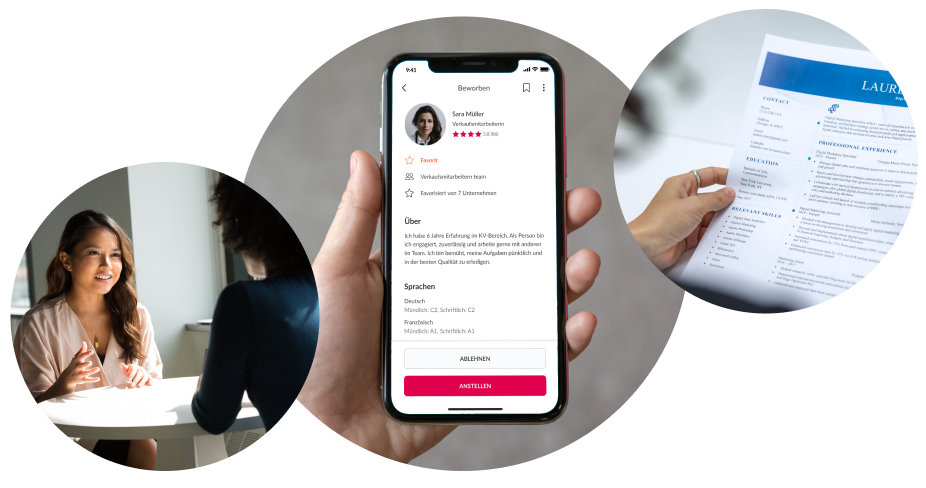There has been a massive change in the employment market recently, caused by the focus on digital transformation on the one hand, and on the character of Generation Z, which has made new demands on working conditions. This, along with the skilled labour shortage, has had some effect on personnel recruitment. According to recent studies, companies need six months on average to fill a position while every tenth company expects to need up to nine months. Today, qualified workers are also often in a position in which they can choose from a selection of job offers. This makes their decisions even more discerning. Companies have to consider these developments and rethink their staff recruitment processes.
To justify these new demands, we will explain in this article what is important in personnel recruitment and highlight several associated aspects.
What is staff recruitment?
Personnel recruitment, also known simply as recruitment or staff recruitment, is a complex process with layers of various key activities. It relates to a targeted search, selection, and hiring of qualified candidates to fill vacancies in a company.
Usually, the recruiting process begins by preparing a profile of requirements or a needs analysis. Any requirements will be outlined in the job description. The publishing of the job advertisement is followed by pre-selecting the candidates, conducting job interviews, finishing the selection procedure, offering contracts, and hiring the person.
We will go into the individual steps of personnel recruitment in more detail below.

An analysis of requirements as the first step in personnel recruitment
Personnel recruitment starts with analysing the current and future staff requirements. The analysis is either based on requirements for a certain group of employees, for instance healthcare staff with specific advanced training, or on specific skills which will be required for a certain time interval. The needs analysis can be used to identify current requirements as well as to anticipate future needs for planned projects. It helps to define the expected qualifications of future staff and it ensures that the recruitment is aligned with the company’s requirements.
The elements of job descriptions
The quality of a job description has a huge influence on the whole recruiting process. Often the description is the deciding factor for whether a potential candidate will apply for the position or look for a job somewhere else. A well-thought-out, attractive job description is part of the major means of communication of the company, not only to attract qualified candidates but also to transmit the company culture and what will be expected of future staff members.
But it certainly is not easy to write a proper job description, and it certainly takes a lot of time. But it is worthwhile to invest the effort, even if there are more pressing matters. Companies that write distinct and precise job advertisements receive more applications, which then again enables them to find suitable staff in less time. Here you will learn what is crucial for a successful job description and how AI tools can help you write appealing texts.
Where can I find new staff members? Identifying candidates and choosing the right channels
As soon as requirements and target groups have been defined, the next step is to give thought to where to find suitable candidates with the required qualifications, skills, and levels of experience.
The following channels are at the recruiters’ disposal: 1) in-house recruitment, 2) career section on company-owned homepage, 3) job portals, 4) social media or 5) outsourcing to a recruitment agency.
In-house recruitment: an efficient way to promote and bind in-house talent
In-house job postings are proved and tested for in-house recruitment. The job postings are published on the intranet or by systematic email notifications for current team members.
This strategy is both uncomplicated and timesaving as existing company structures can be used. Many companies have implemented so-called recommendation programs which encourage staff members to recommend potential candidates for a certain position. If the candidate gets hired for this position, a bonus can be expected. Due to this process, companies can fill vacancies efficiently and relatively budget-friendly with both internal as well as new candidates. In-house job postings and recommendations strengthen the development of an in-house talent pool and support staff retention.
Reaching candidates through the career section on the company homepage
Posting job vacancies on the career section of their homepage enables companies to effectively reach candidates and prove openness for new talents. The methods are simple and cost-efficient.
Using the career section of the company homepage has the benefit that candidates can use the homepage to read up on the company before applying. In this way, candidates can get a better idea of what to expect if they are hired and whether they agree with the company culture. A successful employer branding strategy creates a positive image for (potential) staff members and attracts qualified professionals.
The limited reach, however, could be a disadvantage as a website is usually only visited by people who are already interested in and aware of the company. But in any way, the career section is an important resource for recruiting new staff.
The significance of job portals in the recruitment process
According to current statistics by Statista, 92% of all companies hire online, turning the internet into the top recruiting channel. Publishing job advertisements on various portals like jobs.ch, jobagent.ch, jobscout24.ch, or LinkedIn helps reach a broad target group so companies can choose from a great pool of potential qualified applicants.
However, it can cost a lot of money to place ads on the aforementioned platforms and on top of that it can be very difficult to filter appropriate candidates out of the sheer mass of applications received. In any way, job portals will remain an essential part of modern recruitment thanks to their reach and efficiency.
Free job advertisement with Coople
Unlike on many other job platforms, companies can place job ads on Coople free of charge. Plus, to make placing ads even simpler, Coople offers an automated job description tool to help customers create successful first drafts. With access to an enormous pool of more than 600.000 flexible workers, companies can expect to receive first applications within minutes. After reviewing candidates’ skills and levels of experience, they can be hired with one click. Coople handles all the administration and charges a small fee which covers all the costs. There are no fees for the service or subscription, nor are advance payments or minimum hours required. Coople is completely transparent in terms of personnel cost and customers only pay for services they have actually booked. Find out what Coople charges for hiring staff.
The benefits of social media when recruiting staff
Social media has become vital for personnel recruitment. Platforms like LinkedIn, Facebook, or Twitter (now ’X’) allow the sharing of job postings and active networking to identify potential candidates.
The benefits are the great scope of social media, the targeted search for certain qualifications and skills, and the chance to relate with applicants.
On the downside, it is necessary to build an effective presence on the various social media platforms. Those platforms are at large an indisputable tool to attract talent and to be visible on the job market as a company.
Outsourcing the recruitment process to an agency
By outsourcing the process, the company can assign almost complete responsibility in terms of recruiting to an external recruitment agency. The benefits are that qualified staff will be available at all times, but the company won’t have to put any effort into searching. Companies can therefore flexibly respond to their staff requirements, be it for temporary or permanent positions.
Costs for the recruiting services may vary, depending on the types of service and on the agreement with the agency. Some agencies work with head-hunters who systematically search for qualified personnel they provide the companies with. This can be very efficient; however, it often is more cost intensive. Outsourcing the search process makes sense if companies need expert workers at short notice or if in-house recruitment was too time-consuming. You will learn at the end of this article how the Coople platform can support your company.

The selection process: effectively selecting candidates
Selecting applicants during the recruitment process is a crucial step towards choosing the best possible candidates for the job vacancies.
First, the necessary qualifications, skills, and levels of experience must be reviewed. Evaluating and rating candidates thoroughly is of vital importance. Appropriate measures are structured interviews, psychometric tests, and case studies or other methods of assessment. Prospective candidates should not only be evaluated according to their expertise but also their cultural and personal aptitude. To prevent bias and to introduce various perspectives into the selection process, it is helpful to include several decision makers in the process.
Communication with the applicants must be without ambiguity. Candidates must be informed in due time about the status of the selection process, and they should receive feedback if necessary. Transparency and fairness are essential for the process. Every candidate must have equal odds for the position, irrespective of sex, origin, religion, or other discriminating factors.
As soon as choices for candidates have been made, the final step is preparing the offer and the contract.
Summary
Recruiting personnel is a challenging issue for companies. Finding the best talents requires a structured course of action. Analysing the needs should be the first step as it helps precisely define the requirements of the candidates. The requirements need to be a part of the job description, worded clearly and simply. There are various channels suitable for selecting candidates such as in-house recruitment, the career section of the company’s homepage, job portals, social media, or external recruitment agencies.
It is important to make sure that candidates have the necessary qualifications and skills when selecting and recruiting them. Talent databases are helpful to recruiters as they provide detailed information on potential new staff members and determine whether candidates fit in with the vacant positions. Working with staffing agencies and their experts also helps fill vacancies much faster.
These key factors emphasise the importance of thorough preparation, selection, and rating during the recruitment process to win the most distinguished talents for the respective positions.
How Coople can help you recruit
With CoopleFlex, you can find, hire, and manage qualified workers, all in one place, in the shortest possible time. The solution simplifies the entire recruitment process so that you can concentrate on your core tasks. Coople can provide you with qualified and skilled employees.

